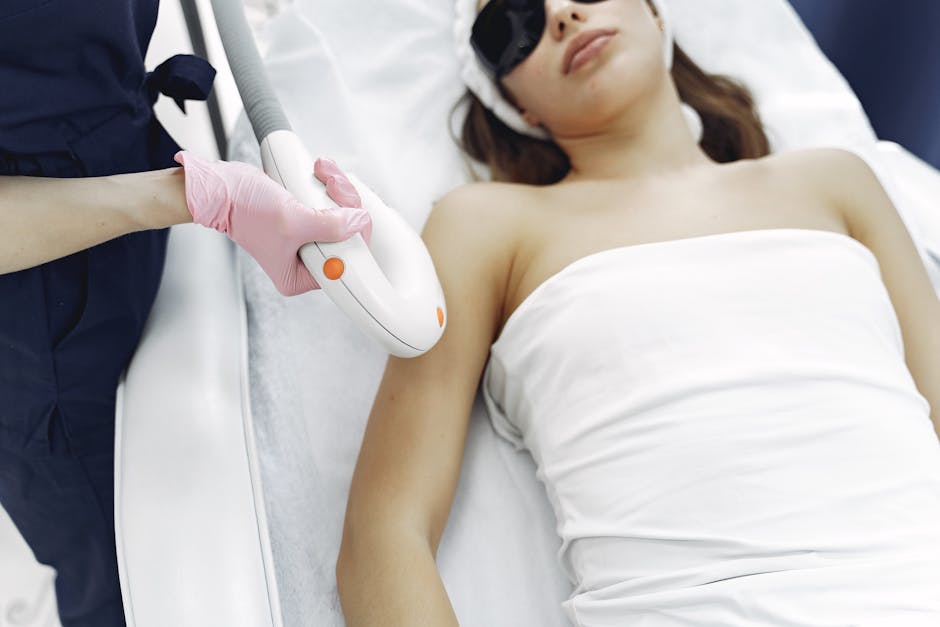Understanding Your Path to Ink-Free Skin
Erasing Ink: The Laser Session Countdown
How many laser sessions you’ll need to remove your tattoo depends on several factors unique to your situation. While no two tattoos fade exactly the same way, here’s what most people can expect:
| Tattoo Type | Typical Session Range |
|---|---|
| Small black tattoos | 3-6 sessions |
| Large black tattoos | 6-10 sessions |
| Small color tattoos | 6-10 sessions |
| Large color tattoos | 10-12+ sessions |
| Amateur tattoos | 3-6 sessions |
| Cover-up tattoos | 8-10+ sessions (for fading) |
Sessions are typically spaced 6-8 weeks apart to allow your body’s lymphatic system to clear away the shattered ink particles between treatments.
That tattoo that once held meaning might now feel like a mistake you carry around every day. Maybe it’s a name from a relationship that ended, a design you chose at eighteen, or simply ink that no longer fits who you’ve become. The good news? Laser technology has made complete or near-complete tattoo removal more achievable than ever before.
The laser works by delivering concentrated light energy that targets the ink pigment in your skin. This energy shatters the ink into tiny particles small enough for your body’s immune system to naturally flush away. Because tattoo ink sits in layers within your skin, and because your body needs time to process the broken-down pigment, multiple sessions are always required.
I’m Dr. Sarah Yovino, a double board-certified specialist in non-surgical medical aesthetics at Ideal Face & Body in Beverly Hills. Through extensive training in advanced laser treatments and pain management techniques, I’ve helped countless patients understand exactly how many laser sessions they’ll need based on their unique tattoo characteristics. Let me walk you through what determines your treatment timeline.
How Laser Tattoo Removal Works: Breaking Down the Ink
Think of laser tattoo removal as a conversation between light and ink—one that happens at lightning speed beneath your skin’s surface.
When we target your tattoo with our advanced laser technology at Ideal Face & Body, we’re delivering highly concentrated pulses of laser energy in specific wavelengths. These aren’t random flashes of light. Each wavelength is carefully chosen because different colors absorb different types of light energy. Black ink, for instance, absorbs nearly all laser wavelengths, which is why it’s typically the easiest to remove.
Here’s where the magic happens: when the ink particles absorb this light energy, they heat up incredibly fast and essentially explode into microscopic fragments. Imagine taking a boulder and shattering it into sand—that’s what’s happening to your tattoo pigment on a cellular level.
Once the ink particles are shattered into these tiny pieces, your body’s lymphatic system kicks into gear. This natural waste-removal system recognizes these fragments as foreign material and gradually flushes them away, much like it would with any other unwanted substance in your body. It’s actually quite beautiful how your body’s natural removal process does most of the work after we’ve broken down the ink.
But here’s the reality: tattoo ink sits in layers at different depths within your skin. Some pigment rests deeper, some sits closer to the surface, and professional tattoos often have multiple layers of densely packed ink. This is exactly why multiple sessions are needed—we can only safely target a certain amount of ink at once, and your lymphatic system needs time between treatments to clear away what we’ve broken down.
The fading process is gradual by design. Each session builds on the previous one, progressively breaking down more ink until your tattoo lightens significantly or disappears entirely. Typically, you’ll notice the most dramatic fading after the first few sessions, with subsequent treatments addressing the stubborn deeper layers.
We use the latest tattoo removal technology at our Beverly Hills practice, including advanced Q-switched lasers and picosecond lasers. These state-of-the-art devices deliver ultra-short pulses of energy—we’re talking trillionths of a second—which means they can shatter ink particles more effectively while minimizing heat damage to your surrounding skin. The result? Better outcomes with fewer potential side effects.
The science behind this process is fascinating, and if you’re curious about the deeper technical details, you can explore clinical guidance on laser principles. But the bottom line is simple: controlled light energy breaks down ink, your body flushes it away, and patience pays off with clearer skin.
How Many Laser Sessions Are Needed? Key Influencing Factors
If only there were a magic crystal ball that could tell you exactly how many laser sessions you’d need to remove your tattoo! Unfortunately, tattoo removal isn’t quite that predictable – but that’s because every tattoo is as unique as the person wearing it.
During your consultation at Ideal Face & Body, we’ll carefully examine your tattoo and discuss several key factors that influence your treatment timeline. Think of it as creating a personalized roadmap for your journey to clearer skin.
Tattoo age plays a surprisingly significant role. That old tattoo from your college days? It’s actually easier to remove than the fresh ink you got last year. Over time, your body naturally starts breaking down ink particles on its own, giving the laser a helpful head start.
Ink colors might be the single most important factor in determining your treatment length. Black ink is our best friend in tattoo removal – it absorbs all laser wavelengths beautifully and typically responds quickly. Dark blues and reds also tend to cooperate well. But those vibrant yellows, bright oranges, purples, and especially stubborn greens and sky blues? They’re the troublemakers that can extend your treatment timeline significantly. Each color requires specific laser wavelengths to break it down effectively.
The ink density in your tattoo matters tremendously. Professional tattoos are usually packed with high-quality, densely concentrated ink applied at consistent depths – which means there’s simply more pigment to break down. Amateur tattoos often contain less ink overall, though the placement can be inconsistent, making them somewhat unpredictable in how they’ll respond.
Your tattoo’s location on your body affects how quickly the ink clears. Tattoos near your heart – like those on your chest, neck, or upper arms – tend to fade faster because blood circulation is stronger in these areas. Your lymphatic system can efficiently sweep away those shattered ink particles. Meanwhile, tattoos on your ankles, hands, or fingers may take longer since circulation is naturally weaker in these extremities.
Skin tone is another crucial consideration. If you have lighter skin with a dark tattoo, there’s excellent contrast that allows the laser to target the ink precisely without affecting surrounding skin. This typically means fewer sessions overall. However, if you have a darker complexion, we need to be more careful and strategic with our approach. The melanin in your skin can also absorb laser energy, so we use specialized settings and wavelengths to protect your skin while still effectively breaking down the ink. This often means more sessions at gentler settings – but your safety and skin health are always our top priority.
Tattoo size is straightforward: larger tattoos simply contain more ink that needs to be broken down and removed. A small design naturally requires fewer sessions than a full sleeve.
Whether your tattoo was done professionally or by an amateur also influences the timeline. Professional tattoos are typically more saturated and uniformly placed, making them more stubborn but predictable. Amateur or “stick-and-poke” tattoos can be wildly variable – sometimes they’re easier to remove because the ink is less dense, but other times the inconsistent depth and unknown ink quality can surprise us.
To help predict your specific treatment needs, we often reference the Kirby-Desai Scale during consultations. This comprehensive assessment tool evaluates all these factors – skin type, location, colors, ink amount, any scarring, and layering – to give us a more accurate estimate of how many laser sessions you’ll need.
How Many Laser Sessions for a Small Black Tattoo vs. a Large Color One?
Let’s get specific about what you can realistically expect based on your tattoo’s size and color combination.
Small black tattoos are the quickest to remove – often requiring just 3-6 sessions. Black ink absorbs all laser wavelengths like a sponge, making it incredibly responsive to treatment. That little black symbol or word you’ve been wanting gone? It’s usually a relatively straightforward process.
Large black tattoos take longer simply because there’s more ink to break down, typically needing 6-10 sessions. The good news is that even though it takes more time, black ink remains consistently responsive throughout the entire treatment process.
Small color tattoos introduce more complexity. When you have multiple colors in a single design, each pigment requires different laser wavelengths to target it effectively. Even a small colorful tattoo often needs 6-10 sessions because we’re essentially treating several different tattoos at once.
Large color tattoos represent the biggest commitment, often requiring 10-12 sessions or more. These are the full-sleeve masterpieces or large back pieces with multiple colors. Each hue needs individual attention, and some pigments are naturally more stubborn than others. We may even use different laser types within a single session to address the full rainbow of colors in your tattoo.
Amateur “stick-and-poke” tattoos can sometimes surprise you in a good way. Because the ink is often less dense and not as deeply embedded, these typically fade in 3-6 sessions. That said, the quality and type of ink used in amateur tattoos can be unpredictable, occasionally leading to varied results.
If you’re planning a cover-up tattoo, the goal shifts slightly. You don’t necessarily need complete removal – just enough fading to create a clean canvas for your tattoo artist to work with. This usually requires 8-10 or more sessions depending on your original tattoo’s characteristics. We actually love working with tattoo artists to achieve the perfect level of lightening for your new design.
How Skin Tone Impacts How Many Laser Sessions You’ll Need
Your natural skin tone plays a significant role in both how many laser sessions you’ll need and how we approach your treatment. Understanding this relationship helps us keep your skin safe while effectively removing your unwanted ink.
The key player here is melanin – the pigment that gives your skin its beautiful color. Here’s the challenge: lasers target pigment. We want them to target the tattoo ink, not the melanin in your skin.
For patients with lighter skin tones and dark tattoos, there’s excellent contrast between the skin and the ink. The laser can easily “see” and focus on the tattoo pigment without significantly affecting surrounding skin. This typically means fewer sessions and a lower risk of unwanted side effects.
However, when treating patients with darker skin tones, we need to be much more thoughtful and precise. With more melanin present in the skin itself, there’s a real risk that the laser could target the skin’s natural pigment instead of (or in addition to) the tattoo ink. This can potentially cause hyperpigmentation (darkening of the skin) or hypopigmentation (lightening of the skin), neither of which we want.
That’s why laser wavelength selection becomes absolutely critical for darker skin tones. At Ideal Face & Body, we use specialized lasers – particularly Nd:YAG lasers – that operate at wavelengths less absorbed by melanin. This means the laser can pass through your skin more safely to target the tattoo ink beneath, minimizing the risk of adverse reactions.
This personalized, safety-first approach often means that patients with darker skin tones need more sessions at lower, gentler energy settings. We’re essentially taking a “slow and steady wins the race” approach – protecting your skin’s health while still effectively breaking down the tattoo ink over time.
We’re always staying current with new tattoo removal methods and advancing technologies to ensure we can safely and effectively treat all skin tones. Your safety and satisfaction are never compromised, regardless of your skin type.
Your Tattoo Removal Journey: What to Expect from Start to Finish
Starting your tattoo removal journey with us at Ideal Face & Body means you’re in experienced hands. We’ve guided hundreds of patients through this process, and we want you to feel completely confident about what lies ahead. Think of us as your partners in this change – we’ll be with you every step of the way.
Getting Ready for Your First Session
The work actually begins before you even arrive for your appointment. For the best possible results, we need your skin in optimal condition. Sun avoidance is absolutely crucial – and I really can’t stress this enough. When your skin is tanned, it contains more melanin, which makes it much harder for the laser to distinguish between your natural pigment and the tattoo ink you’re trying to remove. Plan to stay out of direct sunlight and skip the tanning beds for at least 2-4 weeks before each session. If you’re someone who’s outdoors frequently for work or lifestyle, a broad-spectrum SPF 30+ sunscreen becomes your new best friend.
On the day of your treatment, keep your skin clean and bare – no lotions, creams, perfumes, or makeup on the tattoo area. We also recommend shaving the treatment area about 24 hours beforehand. This isn’t about aesthetics; it’s about ensuring the laser energy reaches the ink directly without being absorbed by surface hair.
What Happens During Your Treatment
When you arrive at our Beverly Hills office, we’ll get you settled and provide protective eyewear to shield your eyes from the laser light. This is standard safety protocol, and yes, you have to wear them – even if they mess up your hair!
Now, let’s talk about the sensation during treatment, because this is usually everyone’s biggest question. Most patients describe it as feeling like a rubber band snapping against the skin, or quick hot pinpricks. Is it comfortable? Not exactly. But is it unbearable? Absolutely not. The pulses are incredibly brief, and we use advanced cooling techniques throughout the session – think cold air devices that numb the area before, during, and after each laser pulse. These cooling methods make a dramatic difference in your comfort level.
The actual session duration might surprise you – it’s much faster than most people expect. A small tattoo might take just a few minutes, while a larger piece could require 30 minutes or more. But remember, the laser is only actually firing for a fraction of that time.
Taking Care of Your Skin Afterward
What happens after your session is just as important as the treatment itself. Right after we finish, the treated area might look white or frosted – this is completely normal and temporary. You’ll likely experience some redness, swelling, and tenderness, similar to a mild sunburn. We’ll apply a soothing ointment and protective dressing before you leave.
Within the first 24 hours, small blisters may form, and over the next few days, you might notice scabs developing. I know it’s tempting, but please resist the urge to pick or pop anything! This is your body’s natural healing process as it works to shed the shattered ink particles. Interfering with this process can lead to infection or scarring, which nobody wants.
Continue protecting the treated area from the sun – and yes, I’m mentioning sun protection again because it’s that important. Keep the area covered or diligently apply sunscreen for several weeks after treatment. You’ll also want to avoid anything that generates excessive heat for the first 24-48 hours: hot showers, saunas, hot tubs, and intense workouts. Heat can increase swelling and discomfort, slowing down your healing.
The Healing Timeline and Why Spacing Matters
The initial healing phase – the redness, swelling, blistering, and scabbing – typically resolves within 1-2 weeks. But here’s what many people don’t realize: your body continues working behind the scenes for much longer. Your lymphatic system is busy flushing out those tiny ink particles for several weeks after each session.
This is precisely why we space your sessions 6-8 weeks apart. This isn’t arbitrary – it’s giving your body the time it needs to clear the ink and allowing your skin to fully recover before we ask it to do this work again. Trying to rush the process by scheduling sessions too close together won’t speed up your results; it will only increase your risk of complications and potentially damage your skin.
Many of our patients tell us that the benefits of laser tattoo removal go far beyond just fading ink. There’s something incredibly liberating about reclaiming that part of your body and the renewed confidence that comes with it. Understanding how many laser sessions you’ll need and what to expect during the healing process helps you plan your journey with realistic expectations – and that makes all the difference in your overall experience.
Frequently Asked Questions about Laser Tattoo Removal
You’re not alone if you have questions about laser tattoo removal – we hear them all the time at Ideal Face & Body! Let’s address some of the most common concerns that come up during consultations.
Is laser tattoo removal painful?
I won’t sugarcoat it – there is some discomfort involved. But here’s the thing: most patients tell us it’s much less painful than actually getting the tattoo in the first place! The sensation is often described as a rubber band snapping against your skin, or quick, hot pinpricks. It’s momentary and manageable, especially with the comfort measures we have in place.
We take your comfort seriously. Before your session, we can apply a topical anesthetic cream to numb the area. During treatment, we use advanced cooling devices that blow cold air onto your skin throughout the procedure, which makes a significant difference. Many of our patients are pleasantly surprised to find that the anticipation of pain is actually worse than the treatment itself.
Each laser pulse is incredibly fast – we’re talking fractions of a second – so any discomfort you feel is very brief. And honestly, knowing that you’re one step closer to being free of that unwanted ink makes it all worthwhile.
Will my tattoo be 100% gone?
This is the question everyone wants a definitive answer to, and I appreciate your need for honesty here. While laser technology has advanced tremendously, I can’t promise that every single tattoo will vanish without a trace. What I can tell you is that we achieve significant fading in nearly all cases, often to the point where your tattoo becomes virtually undetectable.
Many of our patients see complete removal, especially with black ink tattoos. However, certain factors can influence the final outcome. Stubborn ink colors like greens, light blues, and some yellows may leave a faint “ghost image” – a slight shadow where the tattoo once was. If your original tattoo caused trauma to the skin or if there was pre-existing scar tissue, some textural changes might remain even after the ink is gone.
During your consultation, we’ll examine your specific tattoo and give you realistic expectations based on its unique characteristics. We want you to start this journey with a clear understanding of what’s achievable for your particular situation.
What are the potential risks and side effects?
When you choose an experienced provider like our team at Ideal Face & Body, laser tattoo removal is generally very safe. That said, I believe in being upfront about potential risks, even though serious complications are rare.
Hyperpigmentation means the treated area might temporarily darken, while hypopigmentation means it might temporarily lighten. Both of these changes usually resolve on their own over time, though they can occasionally be more persistent, particularly if improper laser settings are used.
Blistering is actually quite common and completely normal – it’s your body’s way of healing and pushing out that shattered ink. The key is to leave blisters alone and let them heal naturally. Scarring is rare, but it can happen if you pick at scabs or blisters, or if you have a history of keloid scarring.
As with any procedure that involves the skin, there’s a small risk of infection. This is why we provide you with detailed aftercare instructions and emphasize the importance of keeping the area clean and protected during healing.
The single most important thing you can do to minimize these risks is to choose a qualified, experienced provider who uses proper techniques and equipment. We adhere to the highest safety standards and customize every treatment to your skin type and tattoo characteristics. For more detailed information on the scientific principles that guide safe laser procedures, you can explore clinical guidance on laser principles.
Your safety and satisfaction are our top priorities, and we’ll be with you every step of the way to ensure your tattoo removal journey is as smooth and successful as possible.
Conclusion: Begin Your Clean Slate Journey in Beverly Hills
Your tattoo removal journey is as unique as the ink itself. Throughout this guide, we’ve walked through the science of how lasers break down stubborn pigments, explored the many factors that determine how many laser sessions you’ll need, and painted a picture of what your experience will look like from consultation to final results.
The truth is, there’s no one-size-fits-all answer to the question of session count. That small black tattoo from college might fade in just a handful of treatments, while a vibrant, professional piece could require a year or more of dedication. But here’s what matters most: with the right expertise and technology, the unwanted ink that’s been weighing on you doesn’t have to be permanent.
At Ideal Face & Body, we’ve built our practice on the belief that every patient deserves honest answers, realistic expectations, and genuinely personalized care. Dr. Sarah Yovino and Dr. Justin Yovino bring years of specialized training in advanced laser treatments to every consultation, taking the time to assess your specific tattoo and create a treatment plan that makes sense for your goals, your skin, and your life.
We’re not just removing ink. We’re helping you reclaim confidence, close chapters, and move forward. Whether you’re clearing the canvas completely or creating the perfect foundation for a cover-up piece, we’ll be with you every step of the way.
Your clean slate is waiting. When you’re ready to start this transformative journey, we’d love to meet you. Schedule your laser tattoo removal consultation with us in Beverly Hills, and let’s write your next chapter together – one session at a time.









